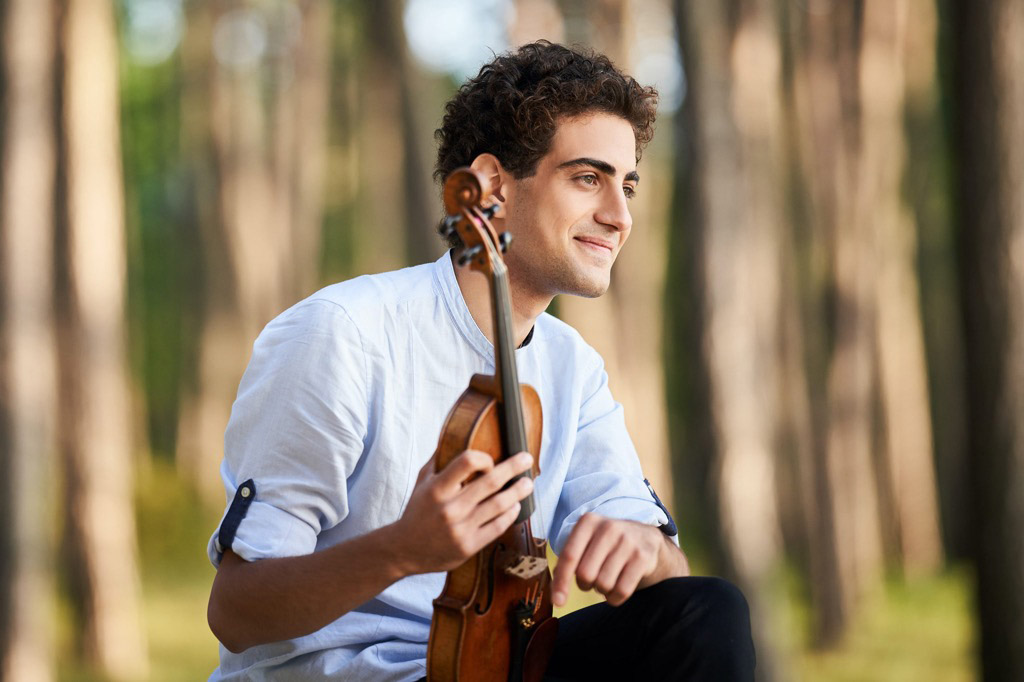Elvin Hoxha Ganiyev
YSAŸE - Six sonatas for solo violin

Photo: Kaupo Kikkas
„He plays with a spectrum of colors in his sound and with an expressiveness that touches every audience.“
Zakhar BRON
„Truly impressed by his tremendous talent.“
Zubin MEHTA
Creating music is often about responding to existing works, especially when it comes to the untouchable legacy of Johann Sebastian Bach, whose influence will likely set standards as long as humanity exists. The Belgian composer Eugène Ysaÿe and the young violinist Elvin Hoxha Ganiyev share a common journey to this musical Olympus. Ysaÿe crafted his response to Bach’s sonatas and partitas in 1923, translating the spirit of his time into music. Ganiyev, in turn, approaches this repertoire with a fresh and untamed energy, holding his own among a highly competitive field of outstanding players.
Eugène Ysaÿe gazed beyond the 19th century, venturing into the musical future. As a master violin virtuoso, he explored the possibilities of the instrument, pushing beyond every apparent limit. After the First World War, his concert activity diminished, partly due to health reasons, but his reflections on music and the violin’s expressive potential deepened.
In June 1923, Ysaÿe composed six sonatas that drew inspiration from Bach’s formal principles. This is why his cycle consists of six works. However, these solo sonatas are much more than a homage to Bach’s originals. Ysaÿe’s pieces break new ground, exploring the diverse and rich possibilities of the early 20th century. They reveal his immense artistic horizon and foresight into the future of music.
The most famous example is the spectacular set of variations on the Dies Irae theme in the second sonata. Yet experiencing all six sonatas together unveils much broader and more diverse aspects of music. Ysaÿe’s genius shines in his innovative techniques, such as bold chromaticism, whole-tone scales, and accessible elements like allusions to Spanish music or Paganini-esque styles. Impressionistic flights and romantic arias act as counterpoints to the wildly virtuosic passages with complex rhythms, rapid arpeggios, and even four-voice double stops. Each sonata is dedicated to one of Ysaÿe’s contemporaries, such as Fritz Kreisler and Manuel Quiroga, underscoring their significance.
Ysaÿe’s lifelong exploration of the violin culminated in this sonata cycle, which feels like the summation of his reflections and a response to his artistic journey. For the young violinist Elvin Hoxha Ganiyev, the exploration of this monumental work is far from complete. He suggests as much in his CD booklet: “For me, these works are like a boundless ocean; every dive reveals something new, immersing you in an infinite palette of colors and emotions.”
Born in 1997 into a distinguished family of musicians, Elvin Hoxha Ganiyev began playing the violin at the age of five. By the time he was ten, he debuted with the Moscow Virtuosi under Vladimir Spivakov at the Kremlin Palace. He later earned his bachelor’s degree at the Escuela Superior de Música Reina Sofía in Spain under Prof. Zakhar Bron and completed his master’s degree at the Hochschule für Musik, Theater und Medien Hannover with Prof. Krzysztof Węgrzyn. Currently, he is preparing for his concert exam at the Folkwang University of the Arts in Essen with Prof. Aleksey Semenenko.
Elvin has performed with numerous renowned orchestras and conductors on international stages and collaborates with ensembles such as the Kremerata Baltica and the LGT Young Soloists, contributing to the album Italian Journey.
He is the recipient of many prestigious international awards, including prizes at the Karol Szymanowski International Music Competition (2023), the George Enescu International Violin Competition (2021), the iPalpiti Special Prize, and the Audience Award at the International Jascha Heifetz Violin Competition.
In 2019, Elvin released his debut album, Say’s 1001 Nights in the Harem Violin Concerto, followed by the single Chausson, Poème Op. 25 in 2020. His latest album, Voyages, Chapter Istanbul (2021), features violin sonatas by Cem Esen and Fazıl Say. He also founded the Afterimage Ensemble, which focuses on performing lesser-known works by composers from minority groups.
Elvin Hoxha Ganiyev is supported by the ÇEV Contemporary Education Foundation’s Turkey Project for Young Talents. He plays a 1715 Filius Andreae violin by Giuseppe Guarneri, accompanied by a bow crafted by Eugène Sartory.